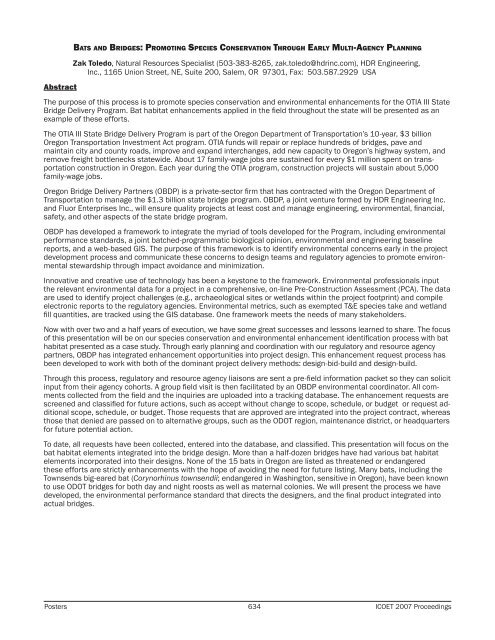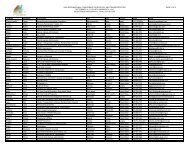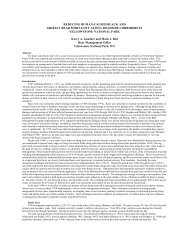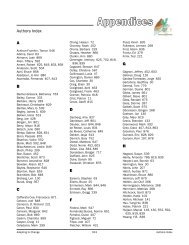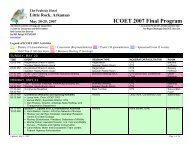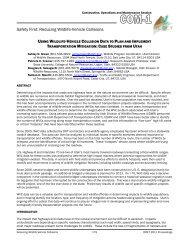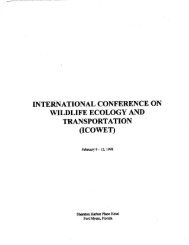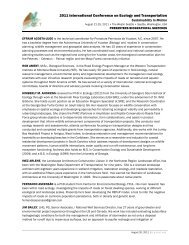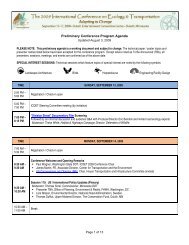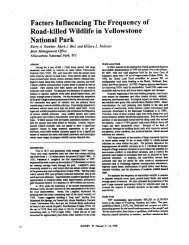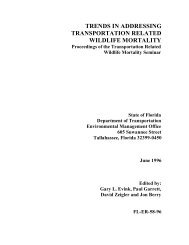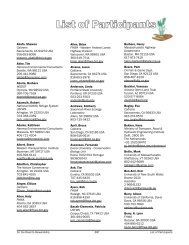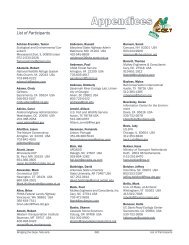Poster Sessions, pages 567-640 - ICOET
Poster Sessions, pages 567-640 - ICOET
Poster Sessions, pages 567-640 - ICOET
Create successful ePaper yourself
Turn your PDF publications into a flip-book with our unique Google optimized e-Paper software.
Abstract<br />
Bats and Bridges: Promoting Species Conservation Through Early Multi-Agency Planning<br />
Zak Toledo, Natural Resources Specialist (503-383-8265, zak.toledo@hdrinc.com), HDR Engineering,<br />
Inc., 1165 Union Street, NE, Suite 200, Salem, OR 97301, Fax: 503.587.2929 USA<br />
The purpose of this process is to promote species conservation and environmental enhancements for the OTIA III State<br />
Bridge Delivery Program. Bat habitat enhancements applied in the field throughout the state will be presented as an<br />
example of these efforts.<br />
The OTIA III State Bridge Delivery Program is part of the Oregon Department of Transportation’s 10-year, $3 billion<br />
Oregon Transportation Investment Act program. OTIA funds will repair or replace hundreds of bridges, pave and<br />
maintain city and county roads, improve and expand interchanges, add new capacity to Oregon’s highway system, and<br />
remove freight bottlenecks statewide. About 17 family-wage jobs are sustained for every $1 million spent on transportation<br />
construction in Oregon. Each year during the OTIA program, construction projects will sustain about 5,000<br />
family-wage jobs.<br />
Oregon Bridge Delivery Partners (OBDP) is a private-sector firm that has contracted with the Oregon Department of<br />
Transportation to manage the $1.3 billion state bridge program. OBDP, a joint venture formed by HDR Engineering Inc.<br />
and Fluor Enterprises Inc., will ensure quality projects at least cost and manage engineering, environmental, financial,<br />
safety, and other aspects of the state bridge program.<br />
OBDP has developed a framework to integrate the myriad of tools developed for the Program, including environmental<br />
performance standards, a joint batched-programmatic biological opinion, environmental and engineering baseline<br />
reports, and a web-based GIS. The purpose of this framework is to identify environmental concerns early in the project<br />
development process and communicate these concerns to design teams and regulatory agencies to promote environmental<br />
stewardship through impact avoidance and minimization.<br />
Innovative and creative use of technology has been a keystone to the framework. Environmental professionals input<br />
the relevant environmental data for a project in a comprehensive, on-line Pre-Construction Assessment (PCA). The data<br />
are used to identify project challenges (e.g., archaeological sites or wetlands within the project footprint) and compile<br />
electronic reports to the regulatory agencies. Environmental metrics, such as exempted T&E species take and wetland<br />
fill quantities, are tracked using the GIS database. One framework meets the needs of many stakeholders.<br />
Now with over two and a half years of execution, we have some great successes and lessons learned to share. The focus<br />
of this presentation will be on our species conservation and environmental enhancement identification process with bat<br />
habitat presented as a case study. Through early planning and coordination with our regulatory and resource agency<br />
partners, OBDP has integrated enhancement opportunities into project design. This enhancement request process has<br />
been developed to work with both of the dominant project delivery methods: design-bid-build and design-build.<br />
Through this process, regulatory and resource agency liaisons are sent a pre-field information packet so they can solicit<br />
input from their agency cohorts. A group field visit is then facilitated by an OBDP environmental coordinator. All comments<br />
collected from the field and the inquiries are uploaded into a tracking database. The enhancement requests are<br />
screened and classified for future actions, such as accept without change to scope, schedule, or budget or request additional<br />
scope, schedule, or budget. Those requests that are approved are integrated into the project contract, whereas<br />
those that denied are passed on to alternative groups, such as the ODOT region, maintenance district, or headquarters<br />
for future potential action.<br />
To date, all requests have been collected, entered into the database, and classified. This presentation will focus on the<br />
bat habitat elements integrated into the bridge design. More than a half-dozen bridges have had various bat habitat<br />
elements incorporated into their designs. None of the 15 bats in Oregon are listed as threatened or endangered<br />
these efforts are strictly enhancements with the hope of avoiding the need for future listing. Many bats, including the<br />
Townsends big-eared bat (Corynorhinus townsendii; endangered in Washington, sensitive in Oregon), have been known<br />
to use ODOT bridges for both day and night roosts as well as maternal colonies. We will present the process we have<br />
developed, the environmental performance standard that directs the designers, and the final product integrated into<br />
actual bridges.<br />
<strong>Poster</strong>s 634 <strong>ICOET</strong> 2007 Proceedings


